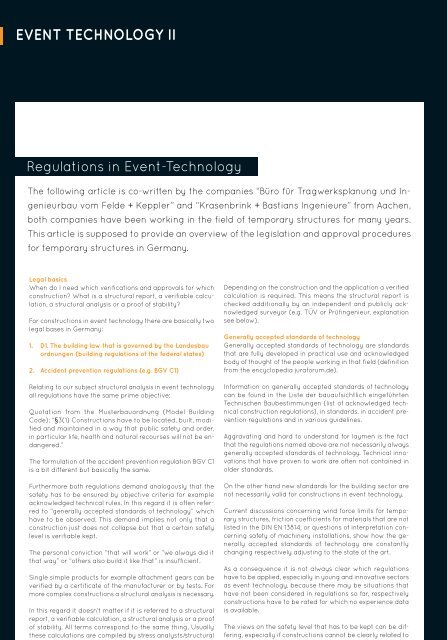o_19jdnovcg1eh21852116govv1lgra.pdf
Sie wollen auch ein ePaper? Erhöhen Sie die Reichweite Ihrer Titel.
YUMPU macht aus Druck-PDFs automatisch weboptimierte ePaper, die Google liebt.
EVENT TECHNOLOGY II<br />
Regulations in Event-Technology<br />
The following article is co-written by the companies “Büro für Tragwerksplanung und Ingenieurbau<br />
vom Felde + Keppler” and “Krasenbrink + Bastians Ingenieure” from Aachen,<br />
both companies have been working in the field of temporary structures for many years.<br />
This article is supposed to provide an overview of the legislation and approval procedures<br />
for temporary structures in Germany.<br />
202<br />
Legal basics<br />
When do I need which verifications and approvals for which<br />
construction? What is a structural report, a verifiable calculation,<br />
a structural analysis or a proof of stability?<br />
For constructions in event technology there are basically two<br />
legal bases in Germany:<br />
1. D1. The building law that is governed by the Landesbau<br />
ordnungen (building regulations of the federal states)<br />
2. Accident prevention regulations (e.g. BGV C1)<br />
Relating to our subject structural analysis in event technology<br />
all regulations have the same prime objective:<br />
Quotation from the Musterbauordnung (Model Building<br />
Code): Ҥ3(1) Constructions have to be located, built, modified<br />
and maintained in a way that public safety and order,<br />
in particular life, health and natural recourses will not be endangered.”<br />
The formulation of the accident prevention regulation BGV C1<br />
is a bit different but basically the same.<br />
Furthermore both regulations demand analogously that the<br />
safety has to be ensured by objective criteria for example<br />
acknowledged technical rules. In this regard it is often referred<br />
to “generally accepted standards of technology” which<br />
have to be observed. This demand implies not only that a<br />
construction just does not collapse but that a certain safety<br />
level is verifiable kept.<br />
The personal conviction “that will work” or “we always did it<br />
that way” or “others also build it like that” is insufficient.<br />
Single simple products for example attachment gears can be<br />
verified by a certificate of the manufacturer or by tests. For<br />
more complex constructions a structural analysis is necessary.<br />
In this regard it doesn’t matter if it is referred to a structural<br />
report, a verifiable calculation, a structural analysis or a proof<br />
of stability. All terms correspond to the same thing. Usually<br />
these calculations are compiled by stress analysts/structural<br />
engineers.<br />
Depending on the construction and the application a verified<br />
calculation is required. This means the structural report is<br />
checked additionally by an independent and publicly acknowledged<br />
surveyor (e.g. TÜV or Prüfingenieur, explanation<br />
see below).<br />
Generally accepted standards of technology<br />
Generally accepted standards of technology are standards<br />
that are fully developed in practical use and acknowledged<br />
body of thought of the people working in that field (definition<br />
from the encyclopedia juraforum.de).<br />
Information on generally accepted standards of technology<br />
can be found in the Liste der bauaufsichtlich eingeführten<br />
Technischen Baubestimmungen (list of acknowledged technical<br />
construction regulations), in standards, in accident prevention<br />
regulations and in various guidelines.<br />
Aggravating and hard to understand for laymen is the fact<br />
that the regulations named above are not necessarily always<br />
generally accepted standards of technology. Technical innovations<br />
that have proven to work are often not contained in<br />
older standards.<br />
On the other hand new standards for the building sector are<br />
not necessarily valid for constructions in event technology.<br />
Current discussions concerning wind force limits for temporary<br />
structures, friction coefficients for materials that are not<br />
listed in the DIN EN 13814, or questions of interpretation concerning<br />
safety of machinery installations, show how the generally<br />
accepted standards of technology are constantly<br />
changing respectively adjusting to the state of the art.<br />
As a consequence it is not always clear which regulations<br />
have to be applied, especially in young and innovative sectors<br />
as event technology, because there may be situations that<br />
have not been considered in regulations so far, respectively<br />
constructions have to be rated for which no experience data<br />
is available.<br />
The views on the safety level that has to be kept can be differing,<br />
especially if constructions cannot be clearly related to<br />
building law or machinery directive.


